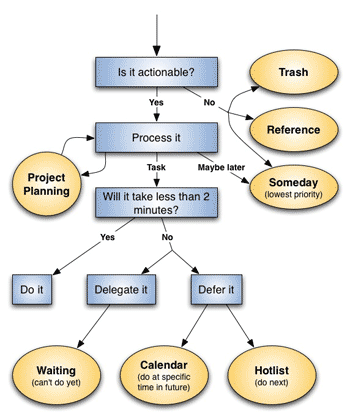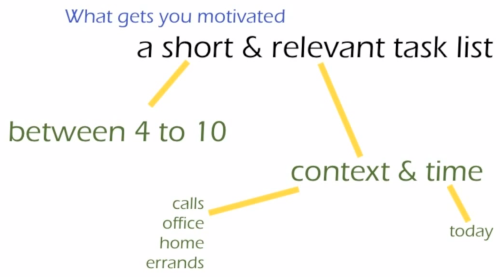Being a youth worker, it is very easy to be busy, but it is not so easy to be productive. Often you are interrupted in what you are doing to do other tasks, whether that is from a student, your minister, a parent, a member of the congregation etc. I think most of us are very good at using a calendar, we put events and meetings into our calendar, and we trust the calendar system, and we check our calendar so we know what we are up to, and we don’t miss calendar events.
But when it comes to tasks we have to do, it can be harder. The worst possible way is to trust you memory, your mind wastes a lot of energy by neurotically keeping those ideas fresh in your memory – you just can’t stop thinking about them. Your thinking process will tend to go in circles, constantly thinking and worrying about the tasks that you must not forget. If you can express your ideas in words and record them outside of your head, your mind will have permission to no longer waste energy trying to remember them. Once all of your tasks are recorded in a trustworthy system that you can review whenever you want, you will no longer have to worry about forgetting to do anything.
Having a long static list can also be demoralising, and unmotivating. And it can be tricky when you are constantly interrupted with new tasks. What we want are short and relevant tasks.
Short and Relevant Task List
If you only see a few doable tasks, you feel like you can do it. And it is possible to only have a few tasks by only viewing relevant tasks. I don’t need to see every task I have to do, I only want to see tasks I can currently do.
relevant tasks = context and time
This may mean I only want to see the task I can do today. Or maybe I am driving, so I put on my bluetooth, and I only want to see the phone calls I have to make.
Getting things Done
Getting Things Done (GTD) is a method for organizing tasks so that you can focus your entire energy and creativity on completing those tasks in a stress free manner. This method was developed by David Allen in his book, Getting Things Done. The main principle of GTD is that recording your tasks in a reliable way – using a system that you trust – will free your mind from trying to remember and prioritize stuff. This recaptured mental energy can be put towards being more productive and efficient.
Collection
The first step to GTD is collecting all of the information that is bouncing around in your head by getting it out of your mind.
If you have not started the collection process yet, you should sit down and type in everything that is on your mind. The average person starting the GTD method will probably have at least 50 tasks bouncing around in their brain that they need to get out.
Processing
The second step to utilizing GTD is to take all of the information that you have collected and process it into actionable pieces with clear next steps. This is where you will define projects and their associated tasks. According to author David Allen, the difference between a project and a task is that “you don’t actually do a project; you can only do action steps related to it.” A project is something that requires more than one action step to complete. You may need to spend some time thinking about a project before you can break it down into its constituent tasks. This is called “Project Planning”. If you don’t have time to do the project planning right now, you should create a task called “Do project planning for…”. This, in itself, is the next step required for the project.
Here is an example of breaking down a project into action steps: “Buy a work Laptop” may be something that you have written down, but this is not a task because it has no clear next steps. It would be better to create a project with an array of small actionable items that you can easily complete, such as: “Determine budget”, “List features that I need”, “Compare prices”, etc.

This flow chart describes how to process and organize all the stuff that is generated by the collection step of GTD. The blue squares explain how to do the “processing” step, and the yellow ovals describe how to do the “organizing” step, which is explained later.
Is it actionable?
In the processing step, the first thing to decide is if the item is actionable. In other words, is it possible to do it? Often we are asked things that are outside of our work, that doesn’t fit into our vision. By saying no straight away saves a lot wasted time. This would be illustrated in the diagram as trash. Sometimes there is no doable task but reference, eg. being emailed minutes from a meeting. Just quickly file it away. And finally sometimes we have a dream for the future, but it is not the right time yet, may be go back to University, start a networking breakfast etc, just put into a someday folder.
Processing it.
If you need to do some project planning to break this item down into actionable next steps, then you can move into the “Project Planning” step.
When you have a legitimate actionable task, the first question is can I do it right now in less than two minutes, and it won’t lead to other tasks, if so just do it. For example your minister asks for the phone number of one the young adults in your group, you can quickly get that, pass it on. You should do such tasks right away because the time it takes to record and manage these types of tasks is longer than the time it takes to just do them.
For longer tasks, you need to decide when you want to do them. This is where you make it relevant. If it needs to be done on or by a certain date or time, or in a particular location, or related to a particular event. Tasks that have no specific time can be put into your task list to be completed at the next possible opportunity. You also have the option of delegating the task to someone else. If you do delegate to somebody else, create a task in a waiting folder to follow up at a particular date. This way you know the task was completed.
Doing
Although the majority of this article was spent describing the previous steps, you will be spending most of your time in the “Doing” stage. In this step, you will use your task list to determine what you should be working on. You can sort this list by a number of different criteria (priority, tags, context, goals, time estimates, etc.) in order to determine which tasks to complete next.
Because you have already taken the time to ensure that each task on your list is actionable, you will not have to think about how to do it. Just do it.
After using this system for a few weeks, you should find that you are much more productive and that your mind is less cluttered and more stress free. That is the goal of “Getting Things Done”.
Software Options
Many people prefer just to use pen an paper for this by adding tasks into a physical calendar. But there is some very good free software out there that will mean you add tasks on your computer or phone, and be able to cross reference it. To be honest it is not about which software option you use, but that you get yourself into a system of using it, and trusting it.
I would recommend any of the following options Toodledo, Astrid, Remember the Milk or Any.do
Much of the knowledge from this article came from the Toodledo website.



